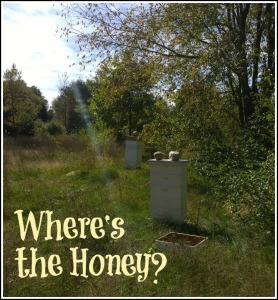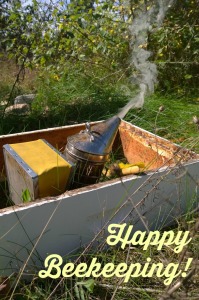Where’s the Honey?
My husband and I have been keeping bees for about four years and I like to think that every year we know less about bees than we did the year before. Oh sure, we’ve learned a lot, but in each new thing we learn, 100 more questions are raised. This year we faced a problem that I never knew could happen. I mean, now looking back, it makes sense that it could happen, but prior to this fall, it was not on my radar of “things to worry about.” Our bees didn’t make enough honey. I don’t mean, “didn’t make enough honey for me to eat or sell.” I mean, didn’t make enough honey for their own winter survival.
I’m not sure this is a very common predicament. As I mentioned it to other beekeepers, I recieved raised eyebrows and a lot of “Really?”s. However, I think this is still a valid post because, to me, this very experience exemplifies what it means to be a beekeeper. The keeping of bees is a constant exercise in the scientific method as well as cause and effect. In addition, some of the things I learned are just interesting in general.
So this fall, my husband and I did as every beekeeper would do. We made arrangements for the wrangling of our two small boys, so that we could inspect our five hives, collect honey, and process it. It was a beautiful fall afternoon and things started out well. The first hive looked okay. There was not a huge surplus of honey, but we pulled out a couple frames. I was even feeling so confident I posted on Facebook this picture with the status, “Honey, coming soon to a jar near you!”
But then things took a turn for the worse. As we began to work through our hives, we found a significant lack of honey. Our strongest hive (a swarm we recaptured earlier in the summer) was six boxes tall at this point. We assumed that hive would yield the motherload of honey, but there were only 6-8 frames of honey. And this trend continued from hive to hive. They were all strong and thriving, but they looked like June hives, not September hives. They were full of brood and the bees were happily working away, completely unaware that in just a few short months they would certainly starve to death.
We raise bees for the bees. We take a little honey for ourselves and we sell a little to friends and family to help pay for the hobby. So this was upsetting, but not devastating. We were more concerned with how we were going to keep these gals alive all winter. I thought about last winter and imagined hiking out into our back field in subzero temperatures through three feet of snow, lugging bricks of fondant.
I did some research online and couldn’t find a whole lot, so I emailed Dr. Meghan Milbrath through the Northern Bee Network and what follows are some possibilities for this behavior:
- The bees have swarmed. If the hive has recently swarmed, it’s possible that what we were seeing was a hive just getting back into production. She said that the Northern Bee Network saw this scenario play out frequently this year: “Sometimes hives with space will swarm if the only space is foundation – bees are looking for a place to immediately put nectar, and will fill in the brood nest in the absence of drawn comb… Many beginner packages swarmed, because the honey flow came on so strong. If you weren’t in the colony for a while – you may have missed this happening.” I can attest to the fact that you can miss a swarm. One of the hives in our backyard swarmed earlier in the summer and, had we not witnessed it while drinking our morning coffee, we probably would have never known it happened. However, this didn’t seem the likely explanation because we had the same lack of honey situation in four hives (our fifth hive was a nuc). This sounds like a problem that might affect one or two, certainly not at the exact same time with the exact same outcome.
- They could have been robbed out. Yellowjackets can be a pest at the end of the summer. When nectar flow tapers off, yellowjackets can wage war on your hives and their honey supply. We didn’t see any evidence of this, however. There were no yellowjackets around the hive, no battles at the front door, no increase in dead bees. Additionally, a strong, thriving hive can usually fight off a yellowjacket attack. We saw evidence of brood to suggest all systems were a “go” in the hives and everything else seemed to be operating as normal. Sometimes a another honeybee hive will rob the honey from their neighbors, but again, you might see bee battles at the front door as the intruders try to enter. You’ll notice a lot of bees entering “empty-handed” and leaving with a heavy load of honey. We did not notice anything out of the ordinary. It looks like business as usualy. Also, it doesn’t seem likely that all four hives could be robbed out equally, all at the same time.
- A disease or mites. I keep coming back to a variable that would have affected all four. We were able to look through many frames because it was such a beautiful day and we did not see any signs of distress in any of the colonies. Again, two of the four were the largest hives we’ve had in four years. All the bees seemed to be very healthy and happy.
- A nectar dearth. “Honey production is incredibly localized – your bees only fly a few miles to collect, so it is really only important how the honey flow is within that range. I do know people who had hives in locations where the honey flow essentially shuts off in July – the bees then have to eat through the stores from June unless they are fed. It also depends on the weather for that particular season -so a big honey location one year can completely change with rain or temperature.” To me, this seems like the most logical explanation. I’ll admit, we didn’t get into the hives as much as we like to this summer because we were incredibly busy, so when Meghan asked me if nectar collection looked normal earlier in the summer, I really couldn’t remember. We take for granted that the bees don’t need us in the summer and this summer seemed pretty normal, weather-wise. There was a severe hail storm that affected about a 1-2 square mile radius around our house. Our house sustained roof damage and two broken windows. In addition, it completely obliterated my large garden, so I wondered if this could be the culprit. At the November Bee Club meeting, Cathy King told me of a couple mile stretch of area south of Kalamazoo that suffered from a drought. So it does make sense that vegetation conditions can be incredibly localized. (How to Recognize a Nectar Dearth)
So, as we have done so many times before, we will be satisfied with a guess as to what happened and then we’ll pick up the pieces and move on. We began researching more effective ways to feed throughout the winter and proceeded with our plans to winterize the hive. Thankfully I have some honey left from last year and we’ll just do the best we can and wait and see what surprise these hives will bring for us the next time we visit.


